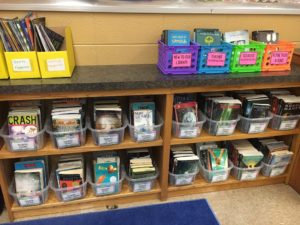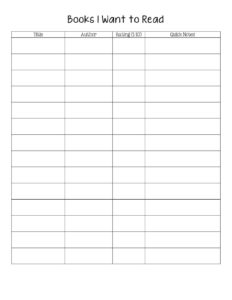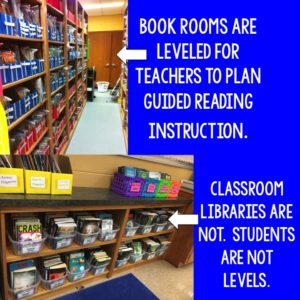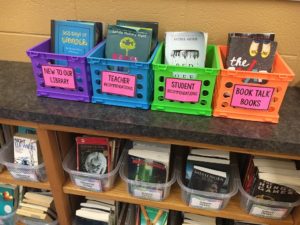A classroom library is the heart of any classroom not just for elementary teachers, but for middle school teachers, too! Below you will find some tips in how to set up, maintain, and use your classroom library across the school year.
Tip One: Organize with Book Bins by Genre, Author, and Topic
The days of a classroom library meaning taking a bunch of books and sticking them on a shelf are over. It’s time to invest in some plastic bins and organize books into categories. The categories I use in my classroom library are mostly by genre, but I also use author and topics. Here are some ideas of book bin titles below.
-Realistic Fiction
-Historical Fiction
-Science Fiction
-Fantasy
-Nonfiction
-Biography
-Popular Authors (Gary Paulson, Walter Dean Myers, Kate DiCamillo, etc.)
-Books in a Series
-Sports Realistic Fiction
-Adventure/Survival Realistic Fiction
-Mystery Realistic Fiction
-Dog Realistic Fiction
Organizing by categories will help students quickly and easily find the bin that suites their interests and be able to access a book they want to read. We all have those students that grab the first book they see from a library stacked with books with no order. This way, students like that who may still grab a book quickly will probably grab from a bin from a genre they will read. A quick organization tip to keep the library organized this way is to write the category name on the inside front cover or use different colored stickers to represent different genres for easy book return to the correct bin.
Tip Two: Have Students Interact with the Classroom Library
Half the battle of being a teacher is remembering to do all of the simple ideas stored up in your mind from Pinterest, reading education blogs, watching other teachers teach, etc. One simple idea for getting students to interact with the classroom library is to give a different group of 2-3 students 5 minutes at the beginning of independent reading time each day to browse the classroom library. My students have their “Books I Want to Read” list in their Reader’s Notebooks, so they can take their Reader’s Notebooks back to the classroom library and jot down book titles they’re interested in reading next as they browse. I have students do this even when they have a current independent reading book. I want my students to be continuous readers who move fluently from one independent reading book to the next. By giving them time to consider books they want to read in the future, this ensures we will avoid the in-between books lull that is associated with off-task behaviors during independent reading time.
Tip Three: Avoid Levels
There are so many reading assessments out there: F&P Benchmark Assessment, DRA, QRI, Lexile, STAR, MAPS, etc. We need these assessments to strategically plan our reading minilessons and guided reading lessons so that we can move students forward as readers. However, we do not need this information to put a label on students. There are so many factors that go into if students are going to be successful with their independent reading book choices: motivation, background knowledge of topic, familiarity with genre, support at home, and the list goes on and on. As teachers, we get levels to help us know where to instruct students and gain knowledge about their strengths and weaknesses as readers. It is meant to be a teaching tool. It was never meant to be a label for students so that they can only pick out of certain book bins in the classroom library, or a way they can compare their reading abilities to other students in the classroom. Restricting students to read only at or near their level is not only dangerous for students with a lower reading level, but it’s also dangerous for students with a higher reading level. As teachers, if we’re doing what we’re supposed to be doing through our reading instruction, independent reading is only one piece of the puzzle when it comes to how students are developing as readers. At different points throughout the school year, they should also be listening to books during interactive read aloud, being instructed at their level during guided reading, conferenced with about their independent reading books during reading conferences, and discussing grade level texts with small groups of students during literature circles. If we’re providing all of these contexts for reading instruction for our students, we do not need to worry if our highest readers are sometimes picking “easy” books or our lowest readers are sometimes picking “hard” books.
You know that story of the baby elephant who was always anchored into the ground with a stake and chain since he was little? The one who grew to be a big, powerful creature and still thought a stake and chain would prevent him from being able to move. Essentially, that is what we’re doing to our students if we’re telling them they can only read books from a certain level or a certain Lexile range. Students are believing that’s who they are as readers and settling for that.
Tip Four: Student Book Recommendations
Last school year, I started opening the floor up at the beginning of our reading minilessons for any students that wanted to quickly talk about a book they would recommend to the class. It was extremely informal with students standing up, showing the book, and saying why they would recommend it. I had always been the one to give book recommendations or show book trailers (which I still do). What I noticed though when I sat back and observed was that students really took to what other students recommended. Making book recommendations casual and fun showed other students that being a reader and liking books is what we do in this classroom. It’s not uncool to like to read. I had certain students that gave more book recommendations than others across the year and some that never took up the opportunity, but I was astounded at the number of different 7th grade students in my classroom who stood up in front of their peers to give at least one book recommendation across the year.
Tip Five: Highlight “Hot Commodity” Books
In 1973 Johnny Carson caused a toilet paper shortage simply by joking about it and reading a newspaper clipping on the radio about it. This, in turn, caused the media to pick up this story and cause an actual toilet paper shortage because of hoarding and panic when in fact, there was never a real toilet paper shortage in the first place. The reason I bring up this proud moment in America’s history is because I’m encouraging you to create a “toilet paper shortage” of sorts in your classroom through advertising hot commodity books. Check out the picture below to see the four new bins I’m trying out on top of my classroom library this school year. There is a bin for books new to our library, a bin of my book recommendations, a bin for books students recommend, and a bin for books students or I give book talks on. These bins will create the attitude of books that are in high demand, which is exactly what I want my students to feel. I want them to be as excited about the next book that they’re going to read as they are about a new video game coming out.
As a last special note, if you’re a content-area classroom teacher, it’s time to start thinking about having a classroom library, too. Slowly work on collecting picture books, nonfiction books, and novels that deal with content you talk about in your classroom. Also, start collecting the most popular middle school novels and books you love that are your favorite so that you have books available whenever needed.
I hope these tips have been helpful for you. Let me know below about what tips you’re excited to try out in your classroom library this school year!










